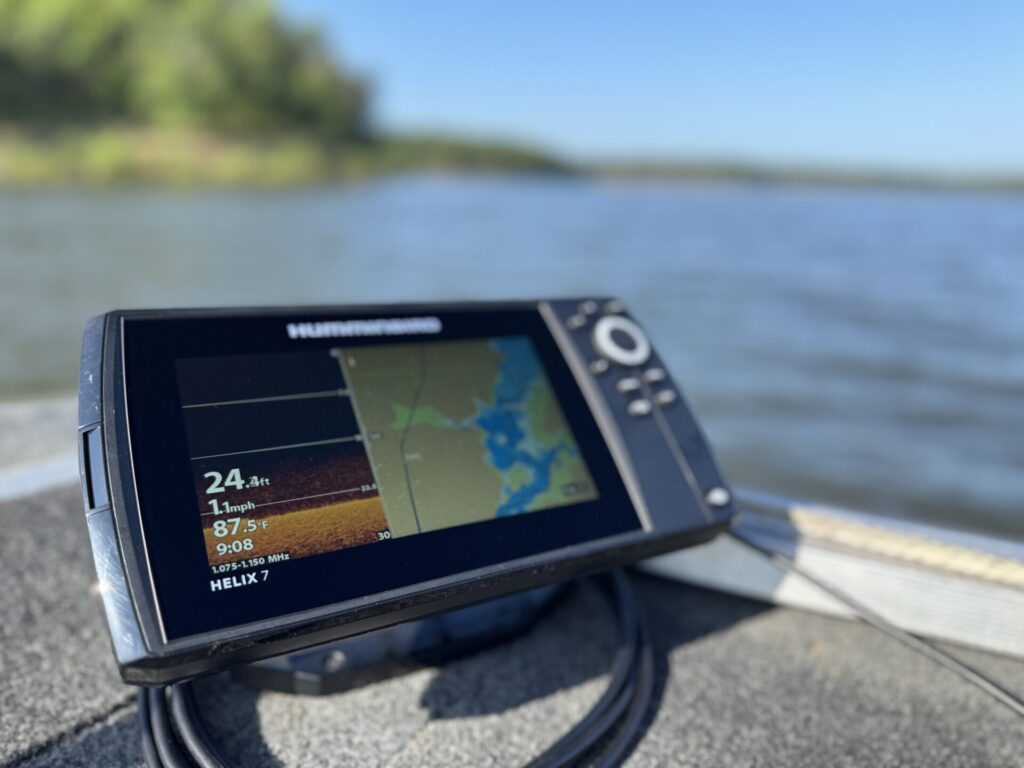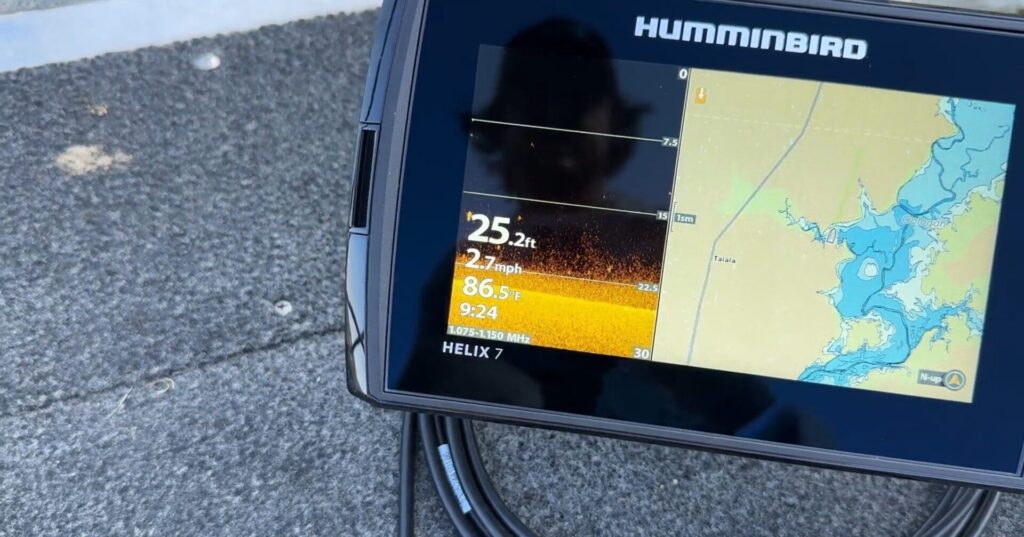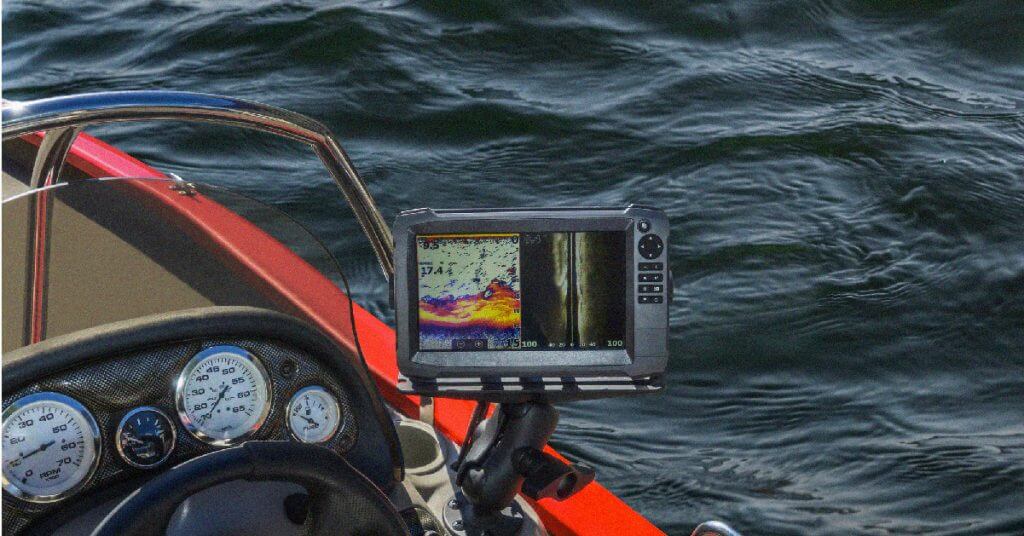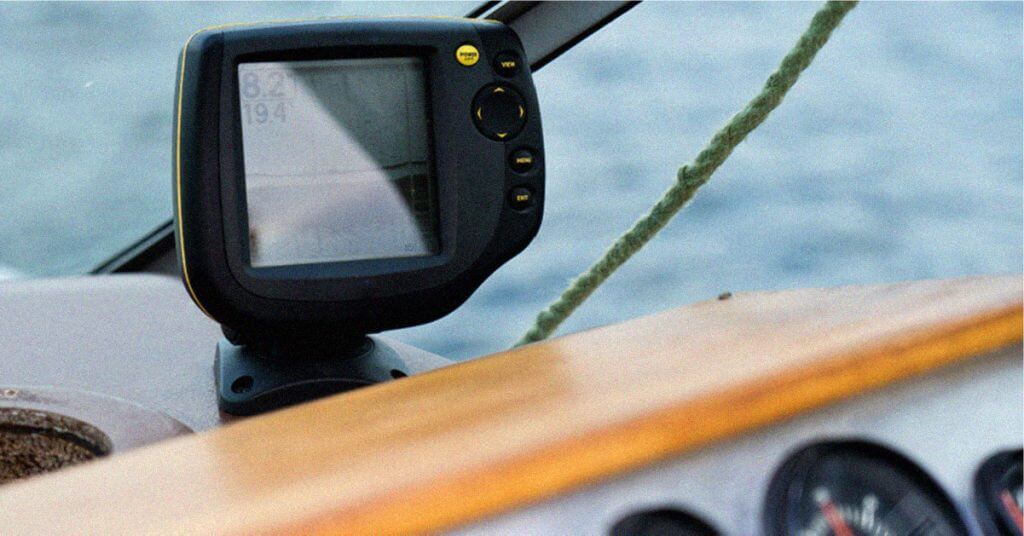Despite being one of Humminbird’s mid-tier options, the Humminbird Helix is thousands of anglers’ favorite fish finder. I’ll explain why it’s the best option for so many weekend warriors.
Last updated: August 14th, 2025
Humminbird Helix Overall Score: 7.89/10

Price: 8/10
Installation process: 8/10
Screen clarity: 9/10
User-friendliness: 7/10
Sonar options: 9/10
Mapping capabilities: 8/10
Networking capabilities: 7/10
Company reputation: 8/10
Customer service: 7/10
Humminbird Helix Pros & Cons
Pros
- Trusted brand
- Crystal clear screen
- Multiple sonar options
- High-quality mapping
- Reasonably priced
Cons
- Not all models offer the same features
- Only the 5-inch and 7-inch screens are now available
- Translating the Humminbird transducer and unit code is a little confusing
The Humminbird Helix is one of the best fish finders for the average angler because it’s manufactured by a trusted brand, has a mind-blowingly crystal-clear screen, and comes at a reasonable price.
Humminbird has been trusted by anglers since 1975. Known for creating innovative and effective fishing electronics, Humminbird continues to give anglers the advantage they need to catch as many fish as possible.
I was blown away by how clear the screen was the first time I turned on my Humminbird Helix 7. Whether the sky is clear or covered with clouds, I have no problem seeing the screen and identifying both structure and fish.
You have plenty of sonar options with the Helix, depending on the transducer you choose. CHIRP is standard, but down imaging and side imaging are also available. I found running the CHIRP and down imaging simultaneously made it even easier to see the fish and structure that were under my boat.
As many anglers know, the most overlooked feature on fish finders is the map. I found the maps on the Humminbird Helix 7 to be very informative though. I can see where I’ve been, but more importantly, I can use it to scout other locations on whatever body of water I’m fishing.
Finally, you won’t have to sell the coordinates to all your secret fishing holes to be able to afford a Helix fish finder. The Helix is reasonably priced for the features and quality of the unit.
However, just because there are many great things about this fish finder doesn’t mean it’s perfect.
My biggest gripe is how Humminbird names the transducers. It’s confusing, even for someone like me who has studied fish finders for the last several years. Pay close attention to the transducer model you’re purchasing, as well as the types of sonar it transmits and receives.
Another downside is that it’s not suitable for anglers looking for a screen larger than 7 inches. At one time, Humminbird offered the Helix in 9- and 10-inch models but recently decided to discontinue them.
Even considering these drawbacks, the Humminbird Helix line of fish finders is still an excellent choice for many anglers. I’ve certainly enjoyed using the Helix 7, as we’ll dive into shortly.
Helix Features and Specs by Model
The Humminbird Helix was once available in five screen sizes (the Helix 9, Helix 10, and Helix 12 have been discontinued), each offering various features and specifications depending on the unit and transducer chosen.
To buy a Humminbird fish finder new, you’ll have to go with either the Helix 5 or Helix 7.
Helix 5
Features:
- Built-in GPS
- Dual-spectrum CHIRP
- Built-in mapping
- Down imaging
Specs:
- Display size: 5″ diagonal
- Display pixel matrix: 800H x 480V
- Grayscale: 16-bit
Helix 7

Features:
- Built-in GPS
- Built-in mapping
- Down imaging
- Dual-spectrum CHIRP
- MEGA imaging
- Bluetooth
- Networking
- MEGA live imaging
Specs:
Grayscale: 16-bit
Display size: 7″
Display pixel matrix: 1024H x 600V
Humminbird Helix Review
I installed the Humminbird Helix 7 on the front of my Bass Tracker several months ago. Since then, I’ve taken it to the lake many times to see how it performs in various conditions. So far, I’ve been impressed with the ease of installation, accuracy, and screen clarity, but that’s not everything.
Price
The cost for the Helix fish finder is incredibly reasonable considering the features it has, such as mapping, down imaging, side imaging, CHIRP, screen quality, and several others. It will by no means bust your budget, making it perfectly priced for the average angler.
Installation Process
I opted to install the fish finder myself, since I’ve installed several others. I found the process to be straightforward and no more complicated than any other fish finder I’ve installed over the years.
I attached the transducer to my Minn Kota Maxxum trolling motor, but I also had the option to install it on the stern of the boat. There was plenty of transducer cable for my 16-foot boat, but the power cable is short and would work best in a kayak.
Screen Clarity

I was most impressed by the screen clarity of the Helix. I did not expect to get a screen as clear as this in a mid-tier fish finder.
I could easily see the screen, regardless of whether the clouds were covering the sun or the sun was glaring down.
User-Friendliness
Maybe it’s because I’m more familiar with Garmin and Lowrance products, but I found the menus and user interface of the Helix to be a bit clumsy. I felt like the menus were from Windows 98—outdated.
Navigating from one page or screen to another was a bit tedious, too. Unless I’m doing something completely wrong, I see lots of room for improvement in this area.
Sonar Options
Since the Helix is a middle-of-the-road fish finder, it has a few sonar options, but not the latest and greatest technologies. You can expect to get down imaging, side imaging, or CHIRP sonar, depending on the transducer you purchase.
I honestly found the CHIRP and down imaging to be clear and accurate—a big help in finding fish that I might have initially overlooked. I was unable to test side imaging because my transducer doesn’t support it, but if it’s anything like down imaging, it will be clear and sharp. Anglers will be able to quickly identify potential fishing spots on either side of their boats.
Mapping Capabilities
I’ve been pretty impressed with the maps that come with the Helix 7. They’re detailed enough for scouting a potential spot and perfect for marking the places where I’ve caught fish. I always know where I’m at thanks to the built-in GPS.
Networking Capabilities
Only the 7-inch screen has networking capabilities, which means it will integrate and communicate with other Humminbird and Minn Kota products that are also One-Boat Network compatible. If you choose to run multiple units, you can quickly share information between them, ensuring your waypoints are always handy.
Company Reputation
Humminbird has built a good reputation in the fishing realm, and it’s one of the leading electronics manufacturers. Many anglers swear by Humminbird products, and I can see why after testing the Helix 7.
Customer Service
I haven’t had a negative experience with Humminbird’s customer service, but during my research, I found several people who claimed they had a terrible time with Humminbird customer service.
Who’s It For?
The Humminbird Helix is perfect for beginners and anglers with a small boat. It’s compact but packed with helpful features. It eliminates confusing features, leaving new users of fishing electronics with only the essentials.
Who Is It Not For?
The Humminbird Helix is not for tournament anglers or guides. The small screen and limited features will leave you frustrated when you’re fishing for money. Instead, I would look at the Humminbird Solix, Xplore, or Apex.
How I Tested the Helix 7

Below, you’ll find the factors I consider critical when testing the Humminbird Helix for this review.
- Cost: I regularly factor in how budget-friendly a unit is based on the features it offers.
- Functionality: If a fish finder is difficult to install, has a ton of unhelpful features, or is difficult to use, I’m less likely to use it. Technology should simplify our lives, not complicate them.
- Features: I want my dollar to stretch as far as possible, but I also don’t want to waste my money on features I’ll never use. I’ll typically look for as many sonar options as possible, like CHIRP, down imaging, and side imaging. GPS/mapping is another critical feature I look for and test.
Final Thoughts: Humminbird Helix Review
The Humminbird Helix is a solid fish finder for the weekend angler. It offers a bright, clear screen with useful features and doesn’t break the bank. However, the user interface leaves lots of room for improvement.
Overall, the Humminbird Helix is one of the best mid-tier fish finders on the market, so if you’re searching, don’t miss out.
Be sure to leave any questions in the comment section!





I have used hummingbird products for years but I recently bought a helix 7 fish finder ,I’d spent almost $900.00 for it I got ill & then COVID came so I didn’t & to this date still haven’t used this equipment I went to download a $200.00 GPS chip & they said that this products expired & needed to be upgraded at the cost of $148.00 more I tried to get them to work with me they refused to its all about the money not standing behind their product & its buyers . So don’t buy their products their only in this to sell stings they don’t stand behind I’m just 1 but with the way they did me on something I paid for & not able to use is wrong & to ask for more $$$ to up grade something they control if it works or not on a computer is gouging the public don’t by these products for sooner than later your going to get screwed I’ll never consider buying from them again Sincerly Larry McFarland
what is the model Helix 7 that has both di and side I cat fish in deep and close to the bank in shallow water ThNks
Hey Danny, if you go for the Helix 7 Mega SI you’ll get both DI and SI. Here’s a link to it: https://www.amazon.com/dp/B07L47R2MZ?tag=yourbassguy-20&geniuslink=true
Thanks for reading!
Not user friendly!